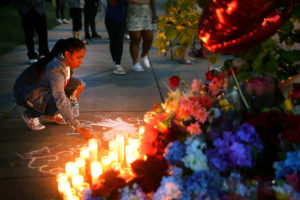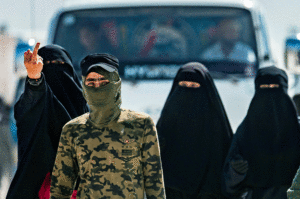Art and Islam often seem like oil and water. Other times, they behave like matches and gasoline.
It is hard to believe that more than 30 years have passed since Ayatollah Khomeini issued his fatwa against Salman Rushdie for The Satanic Verses — longer ago than the fall of the Berlin Wall. I also experienced the combustion created when art meets Islam, back in 2004.
Over that summer, Submission, a 10-minute film that I co-created with Theo van Gogh, was aired on the taxpayer-funded VPRO channel in Amsterdam. I had pulled four very explicitly misogynistic verses out of the holy book, which Theo then inscribed on the bodies of women who acted out the selected verses. After a series of threats, Theo was murdered by a radical Islamist fanatic. Warned that I would be next, I went into hiding.
Dutch society got the message: Submission was pulled and since then nothing of any significance critical of Islam’s founding father or holy book has been aired or exhibited by any mainstream Dutch outlet. Two years later, the message was driven home in another small European country when Flemming Rose, the editor of the Danish newspaper Jyllands-Posten, solicited drawings of the prophet Muhammad after a Danish school teacher wrote a children’s book on the prophet but could find no illustrations for it. After Rose published them, both he and one of the illustrators, Kurt Westergaard, received credible death threats.
The controversy over The Lady of Heaven — a drama about the daughter of the prophet Muhammad, Fatimah — is the latest illustration of the extreme difficulty, not to say danger, of mixing art and Islam. In all three cases, the central concern was over how European countries should accommodate a Muslim minority in Europe without sacrificing freedom of speech. On one side were those who believed Muslims should adapt to the places they now chose to call home; the other side preached that we should exercise patience and compassion.
Yet in all three cases, the debate was hijacked by a minority of Muslims who were willing to use brutal force to terrorise society into silence — threatening infidels and blasphemers, plotting attacks, beheading people and blowing things up. Most political and intellectual leaders in Europe were frightened. They would issue condemnations of the violence, followed by silence. Few expressed uncompromising defences of free speech. Most were inclined to suggest that free speech did not include the right to offend religious believers. This is a fatal caveat — as the staff at Charlie Hebdo discovered in 2015. It’s a lesson Samuel Paty was also forced to learn, after he showed Charlie Hebdo cartoons to his class in a Parisian suburb. It was enough to ignite the flames of Islamist intolerance: an 18-year-old Russian-Muslim refugee of Chechen origin beheaded Paty with a meat cleaver.
In my book Heretic, I argue that there are three sets of Muslims. Islam is a single core creed based on the Qur’an, the words revealed by the angel Gabriel to the Prophet Muhammad, and the Hadith, the accompanying works that detail Muhammad’s life and words. Despite some sectarian divisions — principally the ancient schism between Sunni and Shia — this creed unites all Muslims. All, without exception, know by heart these words: “I bear witness that there is no god but Allah; and Muhammad is his messenger.”
But today there is a contest within Islam for the ownership of that credo and all it entails: Muhammad and his prophethood, his family, his book, and his moral code of practice. In the early days of Islam, when Muhammad was going from door to door canvassing his idea of one God, he used the tool of persuasion through preaching to convert the Arab polytheists. This was when he was in Mecca. Those Muslims of today who love tolerance, charity, and an acceptance of the other use as their moral reference the Muhammad of this period. I call them the “Mecca Muslims”.
However, after ten years of trying this kind of persuasion, Muhammad and his small band of believers had won over no more than 200 believers. So they moved to Medina, where unbelievers were still invited to submit to the one God, Allah — but if they now refused, they were harassed, threatened, and murdered. A big spectacle was made of these brutal tactics. Muslims of today who kill, terrorise and threaten while screaming “Allahu Akbar” are replaying that script from Medina. These are the “Medina Muslims”.
The Mecca Muslims are repelled by the wanton violence of the Medina Muslims. However, they shrink away from debating them, leaving the arena of winning hearts and minds to the radicals. As a consequence, Mecca Muslims who can’t handle the dissonance either leave Islam, as I did, or, much more commonly, tacitly accept the dominance of the Medina Muslims.
There is, however, a third group of Muslim dissenters: the “modifying Muslims”, who know it is hopeless just to keep declaring that Islam is a “religion of peace”, in defiance of successive bouts of Islamist violence. Most of these Muslim dissidents are reforming believers — among them clerics who have come to realise that their religion must change if its followers are not to be condemned to an interminable cycle of violence, intolerance and backwardness.
One such cleric is Yasser Al-Habib, the author of the script for The Lady of Heaven. Al-Habib is a Kuwaiti cleric, a Twelver Shia who rejects the Iranian government’s pretensions to lead the Shia world, and the leader of the Mahdi Servants Union, a UK-based Shia group. Clearly, we are not talking here about secular liberals like Theo van Gogh, Flemming Rose or Charb. I doubt Yasser Al-Habib and I would find much common ground in the unlikely event of our meeting.
Nevertheless, the making of The Lady of Heaven should be seen as a milestone — a significant one, in my view – in the process of Muslim reformation. They picked a woman as their heroine, after all. That in itself is remarkable.
Islamic reform is a minefield, as every Muslim who has ever hinted at the desirability of adapting scripture knows. Yet after decades of the most barbaric violence committed in the name of their faith, some Muslims have had enough. They do not want to leave their faith as I did. They want to haul it into the modern world. This is how I view the Muslim makers of The Lady of Heaven: the central message of their film is that Islam was originally intended — in Mecca — to be a religion of peace.
With discussion no longer taboo, European governments and societies now have to make their minds up about the category of Muslim leaders they wish to support. And so far, they are making the wrong choice. Take the most ardent proponent of a ban on The Lady of Heaven, an imam named Qari Asim, who was a government adviser on Islamophobia and deputy chairman of the anti-Muslim Hatred Working Group. For far too long the British government has consulted and even partnered with duplicitous clergymen like Mr Asim. They represent the non-violent but no less sinister arm of the Medina Muslims, the proponents of dawa — radicalisation that stops short of explicit calls for jihad, but points in that direction. Time and again, in every row over free speech, these people get exposed for who they are. And yet politicians continue to be duped. It took the British government until the weekend to dismiss Asim from his official roles.
None of this is to say that The Lady of Heaven is a good film. But that is not really the point. The Satanic Verses is not Rushdie’s best book. The cartoons in Jyllands-Posten and Charlie Hebdo were not great works of art. Nor, to be honest, was the film I made with Theo van Gogh.
But the mere fact that Muslims in 2022 would venture to release a film about the Muhammad’s daughter is an encouraging step in the ongoing Muslim reformation. This is a movement that all Western governments should support — just as they should ignore without apology all those who cry “blasphemy”, and prosecute anyone who attempts to use violence to deter artistic interpretation of their religion.
Disclaimer
Some of the posts we share are controversial and we do not necessarily agree with them in the whole extend. Sometimes we agree with the content or part of it but we do not agree with the narration or language. Nevertheless we find them somehow interesting, valuable and/or informative or we share them, because we strongly believe in freedom of speech, free press and journalism. We strongly encourage you to have a critical approach to all the content, do your own research and analysis to build your own opinion.
We would be glad to have your feedback.
Source: UnHerd Read the original article here: https://unherd.com




